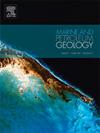Ancient hyperpycnites in deep-lacustrine basins: a comparison between the Jiyang Rift Basin and the Ordos Cratonic Basin, China
IF 3.7
2区 地球科学
Q1 GEOSCIENCES, MULTIDISCIPLINARY
引用次数: 0
Abstract
Recognizing hyperpycnites from ancient rock records in lacustrine basins is critical for understanding the characteristics and formation mechanisms of sediment gravity flow deposits, as hyperpycnites in lacustrine basins may exhibit unique characteristics that differ from well-studied marine hyperpycnites, but these distinctions are not yet fully understood. A comparative study of hyperpycnites in rift (Jiyang Depression) and cratonic (Ordos Basin) lacustrine basins allows to discuss the characteristic features, evolution processes, and distribution patterns of ancient hyperpycnites in two contrasting tectonically-controlled lacustrine basins. Hyperpycnites are composed of clastic sediments, with grain sizes ranging from pebbles to mud. The presence of mixed mud clasts with different colours, the common occurrence of plant fragments with different shapes, and the sedimentary structures such as crude stratification, climbing ripples, and bioturbation serve as recognition criteria of hyperpycnites in lacustrine basins. In addition to inverse then normal grading intervals, hyperpycnites can also be characterized by partial Bouma sequences, hybrid event beds. Depending on the characteristics of the parent flow, the evolution processes of hyperpycnal flows can include cohesive debris flows, hyperconcentrated flows, concentrated flows, and quasi-steady sediment-laden turbulent flows with occasional hybrid gravity flows. Hyperpycnal flows in rift basins range from very highly-efficient systems on ramp margins (hanging-wall slopes) to poorly-efficient systems on border fault margins (footwall), while those in cratonic basins are dominated by very highly-efficient systems. Hyperpycnites in rift basins are characterised by various distribution patterns, including apron, fan-shaped, elongated, and stepped-stacking sandbodies. In contrast, in cratonic basins, distribution patterns are dominated by fan-shaped sandbodies. Along border fault margin of rift basins, hyperpycnites are dominated by coarse-grained debrites and hyperconcentrated flow deposits, while channels and levees are uncommon. In contrast, rift basins and cratonic basins characterized by a ramp margin are dominated by channel, levee, and lobe elements. Hyperpycnites in the early stage of basin filling are easily manifested as elongated sandbodies or stepped-stacking sandbodies from margin areas to basin plain, while fan-shaped sandbodies are more common in the late stage of basin filling in both rift and cratonic lacustrine basins. This research can serve as a reference for studying hyperpycnites in rift and cratonic lacustrine basins.
深湖相盆地古高辉长岩:以济阳裂谷盆地与鄂尔多斯克拉通盆地为例
从湖相盆地的古岩石记录中识别高辉长岩对于理解沉积物重力流沉积的特征和形成机制至关重要,因为湖相盆地的高辉长岩可能表现出与研究充分的海相高辉长岩不同的独特特征,但这些区别尚未得到充分认识。通过裂谷(济阳坳陷)湖盆与克拉通(鄂尔多斯盆地)湖盆的高辉长岩对比研究,探讨了两个构造控制湖盆古高辉长岩的特征、演化过程和分布规律。高辉长岩由碎屑沉积物组成,粒度从卵石到泥浆不等。不同颜色的混合泥屑的存在,不同形状的植物碎块的普遍存在,以及粗层、爬升波纹、生物扰动等沉积构造是湖相盆地高斑岩的识别标准。高斑岩除了具有与正常层序相反的层序外,还具有部分波玛层序、杂化事件层等特征。根据母流的特征,高旋流的演化过程可以包括粘聚碎屑流、高浓流、浓流和准稳定含沙湍流,偶尔有混合重力流。裂谷盆地的高旋流从斜坡边缘(上盘斜坡)的高效体系到边缘断层边缘(下盘)的低效体系不等,而克拉通盆地的高旋流则以高效体系为主。裂谷盆地的高辉长岩具有不同的分布模式,包括围裙状、扇状、细长状和阶梯状堆积砂体。克拉通盆地则以扇状砂体为主。裂谷盆地边界断裂带上,高辉长岩以粗粒碎屑和高浓度流沉积为主,河道和堤防少见。裂谷盆地和克拉通盆地以斜坡边缘为特征,以河道、堤防和裂片元素为主。高辉长岩在盆地充填早期易表现为从边缘区到盆地平原的细长状砂体或阶梯式堆积砂体,而在裂谷和克拉通湖盆中,在盆地充填后期多表现为扇状砂体。该研究可为裂谷湖盆和克拉通湖盆的高辉长岩研究提供参考。
本文章由计算机程序翻译,如有差异,请以英文原文为准。
求助全文
约1分钟内获得全文
求助全文
来源期刊

Marine and Petroleum Geology
地学-地球科学综合
CiteScore
8.80
自引率
14.30%
发文量
475
审稿时长
63 days
期刊介绍:
Marine and Petroleum Geology is the pre-eminent international forum for the exchange of multidisciplinary concepts, interpretations and techniques for all concerned with marine and petroleum geology in industry, government and academia. Rapid bimonthly publication allows early communications of papers or short communications to the geoscience community.
Marine and Petroleum Geology is essential reading for geologists, geophysicists and explorationists in industry, government and academia working in the following areas: marine geology; basin analysis and evaluation; organic geochemistry; reserve/resource estimation; seismic stratigraphy; thermal models of basic evolution; sedimentary geology; continental margins; geophysical interpretation; structural geology/tectonics; formation evaluation techniques; well logging.
 求助内容:
求助内容: 应助结果提醒方式:
应助结果提醒方式:


